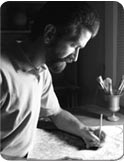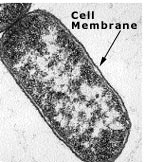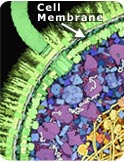
|
|
Image
courtesy of David Goodsell.
|

|

Art
and Science combine to image what cannot be seen.
An
interview with David Goodsell by Mary K. Miller
David
Goodsell is a molecular biologist and associate professor
at Scripps Research Institute in La Jolla, California. His
lab researches drug resistance in HIV, which involves studying
both the structure and function of molecules involved in the
disease. With funding from the National Science Foundation,
Goodsell also writes and creates the illustrations for a column
called "
Molecule
of the Month
" for the
Protein
Data Bank
, an archive of the 3-D protein structures of
18,000 different molecules. This resource is used by structural
chemists, biomedical researchers, geneticists, and educators.
Professor
Goodsell has also had a lifelong passion for art. His paintings,
drawings, and computer-generated illustrations of molecules
and cells have been displayed in galleries and featured on
the covers of magazines and science journals. Goodsell’s
illustrations are based on scientific data from a variety
of sources, including scientific papers, micrographs of individual
molecules, and information about molecular structures gained
from X-ray crystallography. His representations of cells are
both accurate and beautiful. He is the author and illustrator
of several books, including the upcoming "Bionanotechnology:
Lessons from Nature" (Wiley and Sons, 2002).
Goodsell’s
artwork is featured in the "
How
Does a Muscle Work?
" poster.
Mary
K. Miller:
Your artwork opens a new world, something that
can’t really be seen even with a microscope. How much
of this new view is artistic interpretation and how much is
scientific data?
David
Goodsell:
We’re at a stage in the science where a
lot of the major molecular structures are known, but there
are gray areas. Probably two-thirds of the molecules’
structures are known. For the others, I have to speculate
about their size or even the fact that they exist. When I
draw these pictures, I try to imagine what it would be like
inside a cell with molecules and other structures close to
their proper shapes and dimensions. I think this adds more
complexity and maybe a little more realism than previous pictures.
When other people have attempted to draw cells at the level
I’m doing, they simplify things by using circles and
triangles to point out areas of uncertainty. I’ve resisted
that because it breaks the illusion that this is a photograph
or a direct representation. When I made that decision, it
opened the possibility of errors being introduced, but most
of my scientific colleagues understand why I’m doing
that.
Miller:
Is it an aesthetic or scientific choice to
add that realism to your illustrations?
Goodsell: That definitely comes from science. It’s just
in the past decade or so that we’ve been able to do that
because we have so many known structures. But the real challenge
is that when I draw one of those pictures I go to each individual
reference, pull out each individual structure, and combine
them all.
Miller:
Do you consider your computer-generated images as artistic
or aesthetically pleasing as your painted or hand-drawn pictures?

|

|

|
|
Goodsell
combines information from many sources to create illustrations.
He starts with electron micrographs. Here is a transmission
electron micrograph (TEM) of an Escherichia coli bacterium,
magnified 120,000 times.
|
G
oodsell
then looks for molecules’ individual structures.
On the left (above) are proteins, bound within the cell
membrane, that are involved in energy production. The
molecules in the center are involved in protein production.
On the right is a DNA strand with several proteins involved
in reading genetic information.
|
Finally,
Goodsell places all the structures in the proper places,
creating an image of the cell showing all the molecules,
such as in this illustration of an E. coli bacterium.
|
|
Micrograph
courtesy of University of California, Berkeley,
Department of Molecular & Cell Biology,
Instructional Laboratory Program. Illustrations
courtesy of David Goodsell.
|
|
Goodsell:
I try to blur the line between the two. In my computer pictures
I go for a style that is reminiscent of my hand-drawn style
and vice versa. That being said, I certainly put a lot more
of myself into my paintings and hand-drawn pictures. The paintings
also contain more speculation than the computer pictures.
The computer renderings are based directly on data and could
be used for anything from a textbook to a general science
magazine to a journal article. Because there is more speculation
in the paintings, they’re used more as an introduction
rather than to explain something directly.
Miller:
Most people think that science and art operate in completely
different realms, but you manage to combine them. Does the
combination of art and science together contribute more to
your pictures than either alone would do?
Goodsell:
One thing I’ve noted is that scientists and artists are
different. When I go to a scientific conference, the scientists
tend to be very confrontational. Everyone is questioning your
results, which is the way science works. If your results don’t
make it, there was something wrong. When I go to artistic
conferences, everyone is walking in with their approach to
the subject and they tend to be much more supportive. There
isn’t as much questioning because it’s more of a
personal interpretation of what you’re doing.
In
my own work, the combination of art and science gives me a
way to access the wonder of nature. It makes me really look
at results and think about them in a deeper way. The thing
that drives me continually is the beauty of these objects
that I’m working on and being amazed at how unusual they
are. That’s something most scientists don’t spend
much time on, coming up with ways to display their work that
captures their excitement about science.
Miller:
In your scientific work, what is the relationship between
form and function in understanding how proteins and other
biological molecules work?
Goodsell:
It’s like understanding any piece of machinery. You have
to know what it looks like and how its different parts interact
with other parts, the other molecules. The study of structure
also allows us to go in and make changes. For instance, in
my HIV research that’s exactly what we do—we look
at the structure of one of the viral proteins called protease.
Protease cuts other proteins into pieces, a key step in the
ability of HIV to mature in the cell. Because we know the
structure and function of protease, we can design a new molecule
that will go in and block its ability to chop up other proteins.
That’s where the
Protein
Data Bank
comes in handy—for finding molecules that
have specific shapes and functions. There are all kinds of
different molecules in there, some of which are very useful.
Miller:
In your books and in your Web column, you seem to also have
developed your literary talents. Is writing for the general
public something that’s difficult for a scientist?
Goodsell:
Most scientists, it’s true, are hopelessly mired in jargon.
It’s useful for communicating with people who are in
the same field. For me, writing for a broader audience is
much more recent, starting with my books. I was really lucky
to have a mentor in this at UCLA, Richard Dickerson, who was
my graduate advisor. He has a long history of really taking
the time to think about who he’s writing for and encouraging
his students to do the same. It’s a real challenge, trying
to reach a general audience, but it’s really, really
satisfying.
Miller:
Do you consider it a bigger achievement if one of your paintings
lands on the cover of American Scientist magazine than if
one of your scientific articles were appearing inside the
journal?
Goodsell:
I’m more proud of my pictures, because they’re an
expression of me. Dick (Dickerson) who I learned everything
from, once told me that as a scientist you have to divorce
your feelings from your work, so you can stand up to criticism
and not take it personally. I try to exercise that with all
of my research, but I don’t do that with my pictures.
They are uniquely me, and when someone makes a comment about
them they’re making a comment about my aesthetics. They
are closer to an expression of what I feel.
Miller:
Any last thoughts?
Goodsell:
Just the general concept that people are starting to think
more about art and science together. My science colleagues
are much more likely to go to an artist or illustrator to
present their work and artists are going more and more to
scientists to understand these concepts and fold them into
their own work. Artists want to understand more about the
research because there are real implications for society and
they want to comment on that and make the issues clearer for
the public. So the lines are blurring, or at least the sides
are more and more willing to talk. It’s an exciting time
for all of us.
-------------------------
This
story originally appeared in the Cells issue of the "Exploratorium
Magazine."
EXHIBIT
SECTIONS
:
The Stuff of Life
,
Life Needs Energy
,
Making
More Life
,
Change Over Time
©
Exploratorium
| The museum of
science, art and human perception|
Traits
of Life
|

